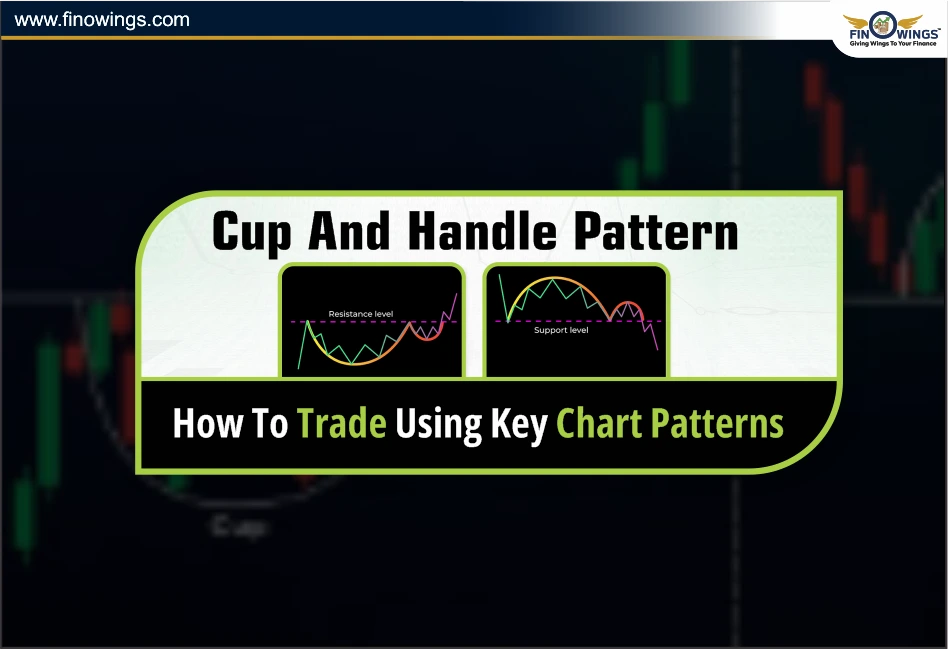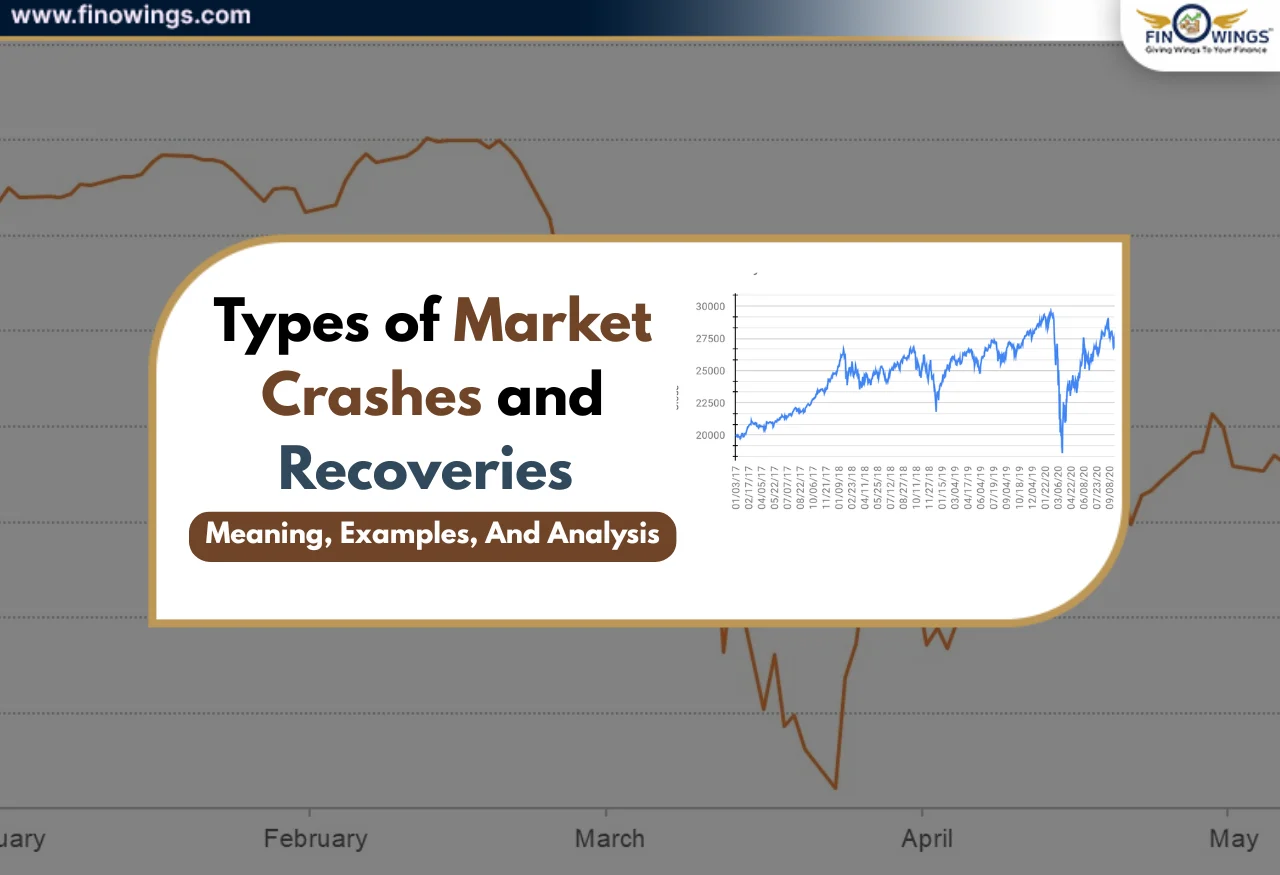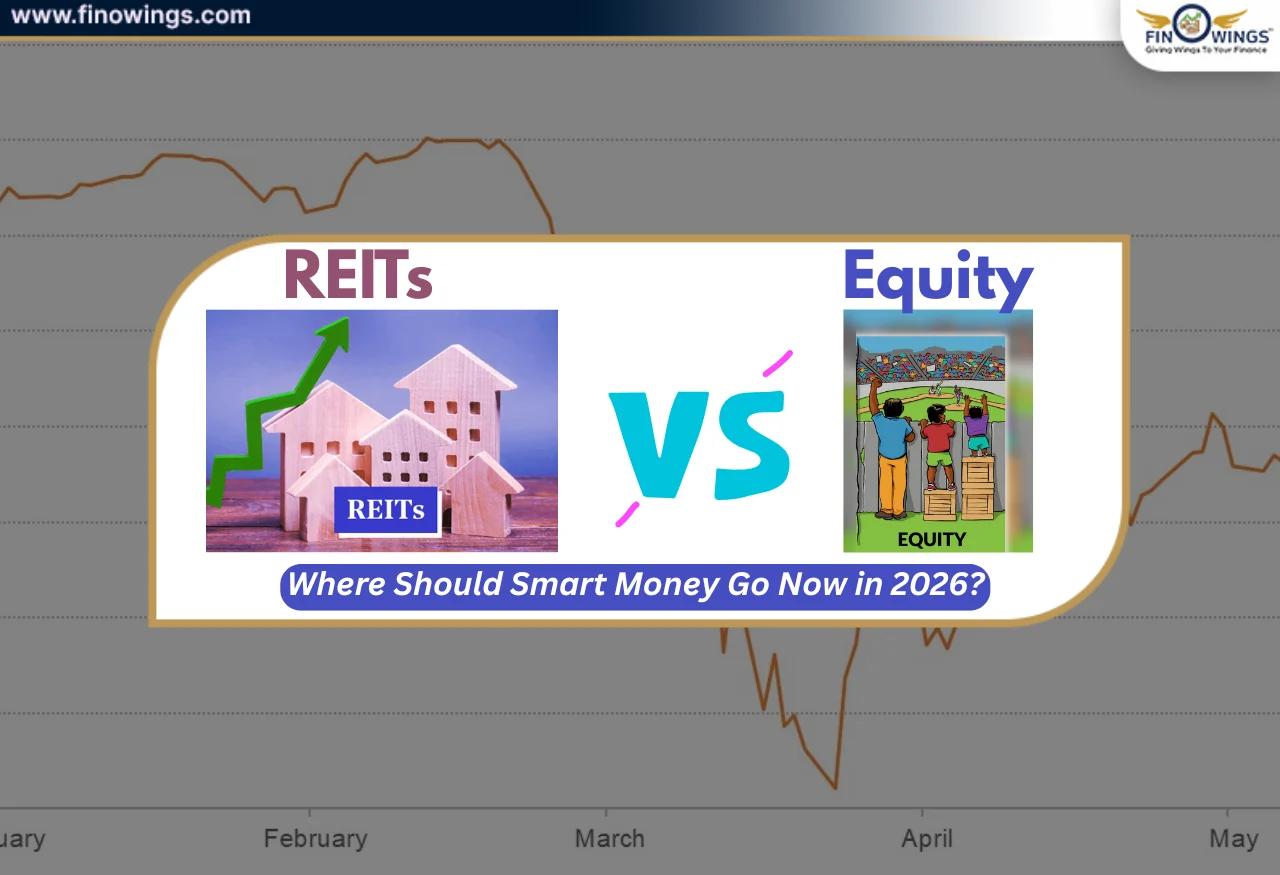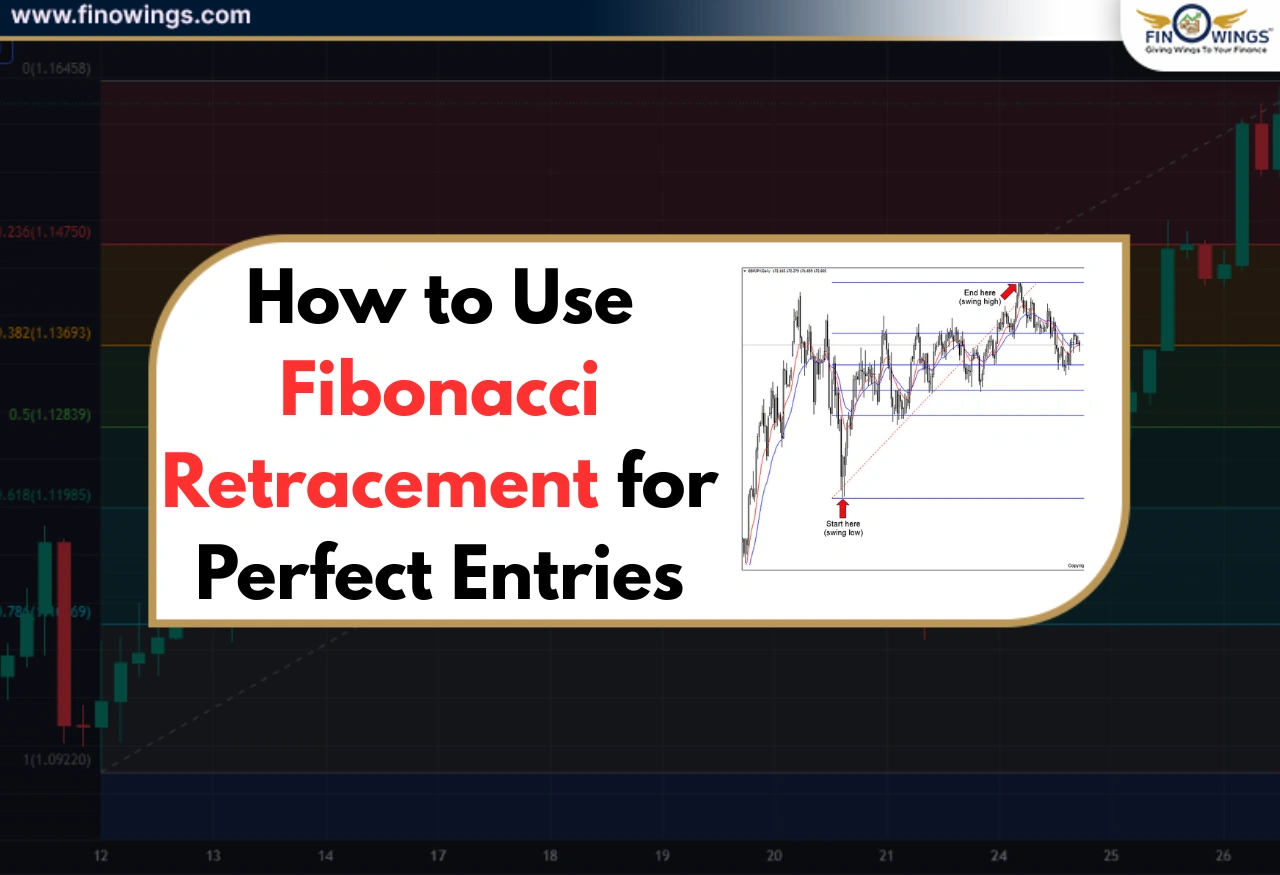Home >> Blog >> Cup and Handle Pattern: How to Trade Using Key Chart Patterns
Cup and Handle Pattern: How to Trade Using Key Chart Patterns

Table of Contents
- Cup and Handle Pattern Overview
- What Does the Cup and Handle Pattern Indicate?
- How Can I Identify the Cup and Handle Pattern?
- Key Metrics to Watch
- How to Trade Using Cup and Handle Pattern?
- Inverted Cup and Handle Pattern
- Inverted Cup and Handle Interpretation
- Benefits of the Cup and Handle Pattern For Investors
- Risks Involved in Cup and Handle Pattern
- Conclusion
Cup and Handle Pattern Overview
Cup and Handle is a famous chart pattern used in technical analysis, which normally describes the bullish/bearish segment of stock prices. The cup has a shape and a handle, which is interpreted as a strong sign of price movement. William J. O’Neil, in his book ‘How to Make Money in Stocks’ brought this pattern to light. A simplified breakdown of the Cup and Handle Pattern is as follows:
1. Cup- The price first falls, then gradually rises, creating a rounded bottom that resembles a "U" (like the bowl of a cup).
2. Handle- After the price trades sideways or travels slightly downward, typically making a smaller dip (the handle). The handle tends to be shorter than the cup and even less pronounced.
Its price breakout means that the price moves above the resistance level pinpointed by the highest point of the cup, i.e. the rim, and that would suggest the former momentum of the price action would continue upward direction.
Mostly, traders would very much want to try this pattern because it is more like a buying point of entry, expecting that price movements would soon increase.
To summarize, this is a technical analysis that signals a bullish breakout, making the Cup and Handle Pattern a strong strategy for traders looking to ride the wave of price increases.
What Does the Cup and Handle Pattern Indicate?
The pattern may work in both ways; it can either be a reversal pattern or a continuous pattern. The cup and handle patterns function as a trend reversal pattern during the downtrend.
The Cup and Handle stock pattern gives a trend reversal when formed in the downtrend, and after the breakout point, the price goes up.
On the other hand, this pattern indicates that an upswing is about to continue. When a cup and handle chart is formed in an upward rally, the price shoots up after the breakout point, which occurs after the completion of the handle formation.
The bullish cup and handle pattern occurs when buyers take a little pause before they take over the market all over again.
In a nutshell, the cup with handle chart says that buyers are trying to drive prices higher by overpowering the sellers. The cup part is formed when prices steeply drop to almost at par with the same level. Price is then pulled back down after the formation of the cup. The downtrend is, however, not as deep as in the cup; by this point, the price begins a strong pullback, forming the handle.
This entire formation is termed the cup-and-handle formation, where buying is likely to be gaining strength with institutions trying all within their means to hold the price higher against a strong selling pressure provided by sellers.
Explore the MMI Index strategy in the Stock Market.
How Can I Identify the Cup and Handle Pattern?
Two crucial components that aid in recognizing the Cup and Handle chart are the cup and the handle. Let’s analyse how you can identify this pattern:-
Before investing in commodities like gold, silver, crude oil, etc, learn some basic concepts before trading with our commodity trading course
1. Prior Trend (Precondition)
- Must have an uptrend before the cup starts forming.
- This demonstrates that the pattern is in a continuation rather than a reversal.
- Make sure to have at least a 30 to 50% rally before the cup forms.
2. Cup Formation
2(a) Shape:
-
A cup shape which is rounded like a U; there should not be a sharp V because that indicates a fading investor.
2(b) Time Duration:
- Minimum time is 7 to 8 weeks on daily charts.
- Can extend towards 6 months or above (mainly in weekly timeframes).
2(c) Depth:
-
Preferably from 12% to 33% retracement from the previous high.
-
A cup is considered too shallow, which indicates weak conviction, while too deep indicates more than 50% may not be an ideal cup.
2(d) Volume Behavior:
- Left side: Volume decreases as price also corrects.
- Bottom: Volume reaches its lowest, featuring a "quiet zone" or base-building.
- Right side: Volume recovers, helping the price recovery slightly increase towards the periphery.
2(e) Resistance:
-
The right lip of the cup sets a volume resistance level that is essential for a breakout.
3. Handle Formation
- Occurs after the cup is completed and the price is close to the peak of the resistance.
- When traders take profits after the cup, there is a pullback, also referred to as the handle.
3(a) Technical Traits:
- Duration: 1 to 4 weeks (Daily Charts)
- Depth: Ranges from 5 to 10% dip. Should not go below 50% of the cup's depth.
- Volume: Light volume in the handle indicates “Healthy Consolidation”.
Note: The ideal situations listed to spot a "cup with handle" pattern are ones that you might not encounter frequently. However, when they do show up, they can produce amazing outcomes. You can still think about using the pattern, though, if the pattern continues to emerge even in the absence of the ideal opportunity.
3(b) Pattern type:
- Often resembles a bullish flag, falling wedge, or descending channel.
- Should not break below the 50-day MA (Ideally).
Where This Pattern forms?
- This pattern most usually forms in a bullish environment, when an asset is already in an uptrend.
- There is usually a breakout zone, where the price approaches its prior high and starts to consolidate.
- It is best to use this pattern on daily or weekly charts, with weekly timeframes being more reliable because of the low noise present.
Read to understand Put call ratio in trading.
How to Use It?
-
Breakout Confirmation
Once the handle forms, the price offers a perfect entry point by moving above the resistance zone on strong volume.
-
Entry Point
You enter right after the breakout; the more conservative traders, however, would want an additional confirmation candle.
-
Stop Loss
Put a stop loss just below the low of the handle or the 50-day moving average in order to protect your capital.
-
Target
The price move will usually be around the distance equal to the depth of the cup.
e.g., If the depth of the cup is 30 points, then the break-out target will be 30 points above the breakout level.
-
Volume Confirmation
The breakout should ideally be accompanied by above-average volume that adds to the pattern's reliability.
4. Breakout
4(a) Trigger point:
-
When the price closes above the resistance formed by the cup's right rim.
4(b) Volume Confirmation:
-
The "must have breakout" phenomenon should be aided by a 40-50% increase in volume over typical.
4(c) Price Target:
-
Target = figure out the depth of the cup + breakout level
Images Source : Tradingview
Key Metrics to Watch
|
Metric |
Ideal Range |
|
Cup Depth |
12 to 33% of the peak |
|
Handle Drop |
5 to 10% |
|
Handle Duration |
1 to 4 weeks |
|
Volume Breakout |
> 40% avg |
|
Timeframe |
Daily or weekly chart |
Key Validation Rules:
- Cup symmetry states that the right and left sides should almost match.
- No clear V-shape recovery.
- The handle must cut above the midpoint of the cup.
- The direction of the trend must be upward.
Invalid Pattern Red Flags:
- Handle dips below the midpoint of the cup
- Cup forms after downtrend (it's not a continuation)
- No volume confirmation on breakout
- Too sharp a recovery (V-shape) = lack of consolidation.
Some Tips:
- For using Fibonacci retracement as a measurement to check cup depth, it is ideal between 38.2% to 50%.
- Use RSI > 50, MACD bullish crossover, and also the 50/200 EMA alignment for confirmation.
- Institutional accumulation is the result of tight price action at the handle before the breakout.
How to Trade Using Cup and Handle Pattern?
There is a proper, simple strategy behind the trading cup and handle. You can follow this strategy to make an informed decision:-
1. Identifying the Pattern Correctly
Confirm before you trade:-
- The cup is U-shaped rather than sharply V-shaped.
- The handle should be a downward consolidation.
- Declining volume in the handle and spiking on breakout.
- A cup should have been preceded by an upward movement (minimum 30-40%).
To learn the detailed Technical analysis in a simple way, even if you are a beginner, buy our dedicated Stock Market Technical Analysis course
2. Mark Key Levels
|
Level |
Description |
|
Resistance |
Right rim of the cup - breakout level |
|
Support |
Bottom of the handle or near 20/50 EMA |
|
Stop-Loss |
Just below the handle, low |
|
Target |
Cup depth added to the breakout point |
3. Entry Settings
3(a) Aggressive Entry (for more seasoned traders)
- End of the handle (with a breakout in mind)
- Risk: There could be a false breakout.
- Reward: A more favorable entry price.
3(b) Conservative Entry (Recommended)
- A trade should only be taken once the candle closes above the breakout level (right rim).
- Candle closes with a confirmation of a volume spike (40-50% above avg).
4. Set Your Stop-Loss
- Your SL should be placed just below the lower part of the handle.
- If the handle is neat and tight, the SL will be small = good risk/reward.
- An ATR (Average True Range)-based SL would also be a very good choice for volatility-based SL placement.
5. Price Target
Formula:
Target = Breakout Level + Cup Depth
Cup bottom = 180
Cup top = 220
Breakout at 220, Cup Depth = 40
Target = 220+40 = 260
6. Volume Confirmation
- Without volume confirmation, no breakout is valid.
- Volume should be greater than that of the 50-day average volume breakout candle.
7. Watch Out for Fake Breakouts
- The price breaks out and closes below a resistance level, it's time to sit tight.
- Entry by Retest: The method allows the price to break out, come back, retest Rs. 220, and hold before entering.
|
Rule |
Details |
|
Risk per Trade |
Max 1-2% of your capital |
|
Risk Ratio |
Minimum 2:1 |
|
Position Sizing |
Based on SL distance and capital |
Inverted Cup and Handle Pattern
The Inverted Cup and handle pattern is just the opposite of the usual cup and handle, which generally forms a “U” shape in the candlestick pattern. Hence, the inverted cup and handle form an inverted “U” style in the candlestick.
This Reverse Cup and handle pattern shows the bearish cup and handle pattern. The price action makes a double top pattern as the price hits a new high by drifting sideways after the formation of an inverted "U" pattern. This last high is lower than the previous high (auger high or the inverted cup) and rolls lower.
Thus, the resulting pattern shows a smaller inverted "U" or "V." This part is defined as the handle. (It is smaller than the cup section formed beforehand.) This pattern is a well-known bearish pattern, and the breakout point is expected to behave as the point of initiation of the bearish trend.
Inverted Cup and Handle Interpretation
This pattern is an indicator of the start of a downtrend. It can be viewed either as a reversal or a continuation. The formation of an inverted cup and handle pattern during a downtrend is simply a reinforcement for traders that the continuation of the downtrend is likely.
An inverted cup and handle pattern forming in an uptrend is considered a reversal setup. Generally speaking, after it has shown the pattern, the price could fall from the breakout point, which is the point traders take as an opportunity to short-sell.
Benefits of the Cup and Handle Pattern For Investors
Here are 5 advantages of using the Cup and Handle chart pattern for investors.
- Very easy to identify: The pattern itself resembles a teacup, thus easily identified the pattern.
- Always indicates an Uptrend: Often, a stock tends to rise upward following the completion of the cup and handle pattern.
- Minimal-risk Entry: Helps the investors to buy when the downside is limited.
- Strong Breakout: Shows a strong signal when the stock breaks out of the handle.
- Long-Term Applicability: This pattern is more useful to investors who wish to see a steady, long-term flow of returns.
Risks Involved in Cup and Handle Pattern
While using the Cup and Handle chart pattern, below are 5 major risks that every trader should be aware of:
- False Breakouts: The breakout from the handle can be unachieved, resulting in a false signal and subsequently incurring losses.
- Pattern Misidentification: A different pattern or price movement might be mistaken for a cup and handle, resulting in bad trading calls.
- Low Volume Confirmation: Under such conditions, a breakout may not be considered of great importance without much volume because there exists a high possibility for a quick reversal in price.
- Too Long or Short a Duration for Handle or Cup: The more prolonged or short-lived the cup or handle, the less reliability of such the pattern ramp.
- Change in Market Sentiment: The formation may be negated by unforeseen news or general market movements, which could lead to an unexpected price reaction.
Conclusion
The Cup and Handle pattern is one of the most reliable and powerful chart patterns in technical analysis. It gives traders and investors a methodical roadmap for identifying potential bullish breakouts. You will get high probability buying chances with a good risk-to-reward ratio when the price moves strike with volume research to give it a great appearance.
Your success will be determined by your ability to accurately identify the depth, duration, volume behavior, and breakout confirmation of the cup and handle, whether you are navigating a continuation pattern in an uptrend or spotting a reversal in a downtrend. Moreover, your confirmation method and trade precision can be enhanced by including metrics such as RSI, MACD, Fibonacci levels, and EMAs.
Even if the pattern has a lot of potential, it's crucial to be on the lookout for shifts, false breakouts, and pattern misidentification.
Disclaimer: This blog is only for educational purposes and should not be considered as any investment or trading or buy, or sell advice. If any buy or sell, or trading decision is made solely from this blog, then the Author of this content or the company shall not be responsible for any loss. Always conduct research and discuss with an eligible financial advisor before making any monetary decision.
Author
Frequently Asked Questions
Yes, this pattern generally shows a bullish or upward trend when the price starts rallying.
The Cup and Handle is a pattern for the bullish continuation after an uptrend. The cup is a round-shaped U, and after the U shape, there is a slight downturn forming the handle. The pattern is said to be completed as soon as the price breaks out above the cup’s resistance on strong volume.
The ideal handle should ideally be from 5 to 15% deep, and the target on breakout would be equal to the depth of the cup, added to that breakout point. Drying up of volumes should ideally happen during the formation of the cup-and-handle pattern, whereas on breakout, volumes should surge upwards. A pattern fails if the price dips below the low of the handle, and also if it breaks out with weak volume.
By measuring the cup's depth and adding it to the breakout point, the target price for the cup and handle pattern is established.






.webp)











